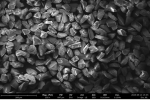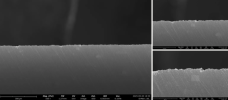CM,
It would be an interesting race. Clearly one advantage for the Nubatamas is simply size - they are thicker. The Shapton Pro stones average 17 mm thick. The Glassstones are half glass - the stone portion is about 7 mm thick and slightly faster wearing than the pro stones in general. So on longevity the Pro stones are longer lasting than the GS for the same grit.
The Nubatamas are anywhere from 25 mm (inch) thick to 30 mm to 50 mm thick - so as much as over 7 times thicker comparing say a 150 Nubatama Bamboo to a 120 GlassStone.
Just as a general rule, coarser stones wear faster for any series of stones so it is best to compare wear rates for a given grit.
So the 2k Black (actually more of an dark olive green) will wear faster than the 2k speckled but it is a thicker stone and the 2k Bamboo is not quite as hard as the 2k speckled stone but is more specialized. For your purposes, I'd suggest the 2k Speckled. Since it will generate more mud than a 2k Pro stone, it will wear slightly faster and probably cut slightly quicker than the 2k Pro. The 5k Pro stone should wear slower than either the 4k, 5k or 6k Nubatama stones, ume or pro but they are thicker.
At some point I would suggest that stone wear should not be your overriding criteria. All of these stones will last you for many years of sharpening unless you are sharpening a bunch of knives every day. I mean when's the last time you sharpened 10,000 knives? A slow wearing stone that you don't enjoy using will wear even slower because it will be the stone you don't use

I find I prefer a bit more feedback in a stone. I find the 5k pro gives very little feedback. This was one of the first stones I owned among Japanese synthetic stones. I'm not saying I think it is a bad stone at all, but for most instances, I go for the 5k Nubatama over the other 4k and 6k Nubatamas or my 4k or 6k Glassstone or 5k pro stone because I enjoy using the stone and the results I get with it. If I am following it with a Japanese Natural stone, now it isn't even a contest - the 5k Nubatama wins hands down among all of these choices as it best preserves a Kasumi finish as well as working well with a wide range of steels too.
So now we have covered choices for harder steels pretty much. For abrasion resistant steels, I like diamond plates especially at the low end. The 140 Atoma is outstanding in this regard. It cuts fast but leaves deep scratches and stays flat. You can continue to refine the edge with finer diamond plates or convert it to a stone finish at 150 grit. Even for abrasion resistant steels diamond plates should be done in smaller jumps 140 400 600 1200. If you have to skip one, skip the 600. So from there you can go to CBN loaded strops and skip stones entirely or even start lower. So you can go as low as 80 microns in CBN which is coarse enough to follow a 220 grit belt for instance on a grinder. I have people who do this routinely on belt grinders. If you want to go into detail on a suggested sequence for using CBN, just contact me for details as I think I've already stuck a lot of info in this post and it can get confusing. There is yet another possibility of using CBN ON the sharpening stones for the abrasion resistant steels and otherwise using the stones as is for everything else. So for instance, putting a 4 micron CBN emulsion on a 4k stone (any of them) will supercharge it for dealing with S90v type steels.
---
Ken


